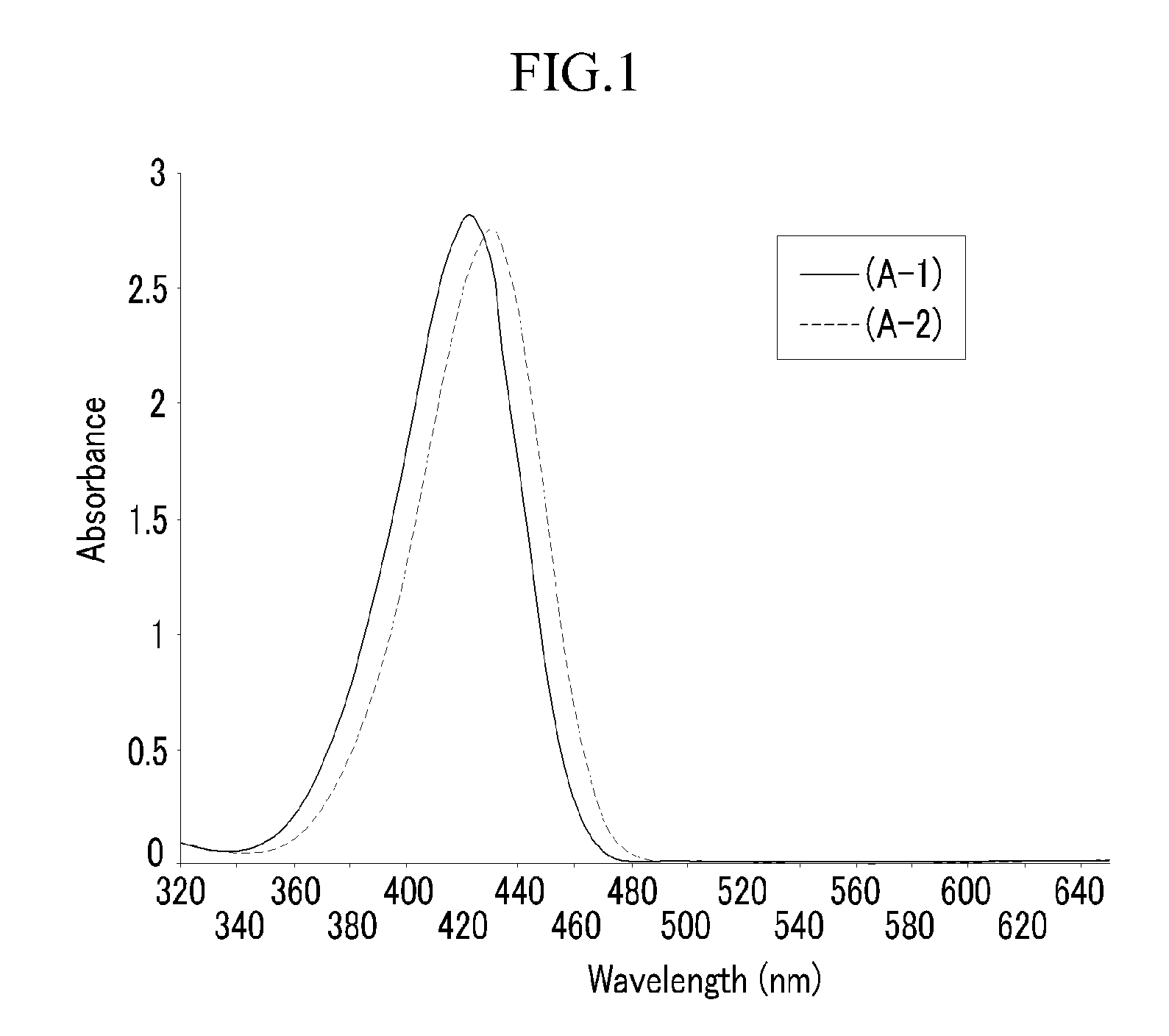Photosensitive Resin Composition for Color Filter, and Color Filter Using the Same
a technology of color filter and resin composition, which is applied in the direction of photomechanical equipment, instruments, originals for photomechanical treatment, etc., can solve the problems of pigment dispersion method not providing the desired level of color characteristics such as luminance and contrast ratio, and the overall increase of pigment amount, etc., to achieve excellent heat resistance and durability, high luminance, and high absorption
- Summary
- Abstract
- Description
- Claims
- Application Information
AI Technical Summary
Benefits of technology
Problems solved by technology
Method used
Image
Examples
example 1
[0142]1.7 g of the photopolymerization initiator (C) is dissolved in 31.1 g of propylene glycol monomethyl ether acetate and 17.3 g of ethyl 3-ethoxypropionate as the solvent (E). The solution is agitated for 2 hours at room temperature. Next, 3.9 g of a yellow dye (A-1) represented by the above Chemical Formula 6, 3.5 g of the acrylic-based binder resin (B), and 8.5 g of the photopolymerization monomer (D) are added thereto. The mixture is agitated for 2 hours at room temperature. Then, 33.8 g of the pigment (A′-1) is added thereto. The resulting mixture is agitated for 1 hour at room temperature. Then, 0.2 g of the surfactant (F) is added thereto. The mixture is agitated for 1 hour at room temperature. The solution is filtrated three times to remove impurities, preparing a photosensitive resin composition for a color filter.
example 2
[0143]A photosensitive resin composition for a color filter is prepared according to the same method as Example 1, except for using 3.9 g of a yellow dye (A-2) represented by the above Chemical Formula 7 instead of 3.9 g of the dye (A-1).
example 3
[0145]1.7 g of the photopolymerization initiator (C) is dissolved in 31.1 g of propylene glycol monomethyl ether acetate and 17.3 g of ethyl 3-ethoxypropionate as the solvent (E). The solution is agitated for 2 hours at room temperature. Next, 1.2 g of a yellow dye (A-1) represented by the above Chemical Formula 6, 3.5 g of the acrylic-based binder resin (B), and 8.5 g of the photopolymerization monomer (D) are added thereto. The mixture is agitated for 2 hours at room temperature. Then, 33.8 g of the pigment (A′-1) and 2.7 g of the pigment (A′-2) are added thereto. The resulting product is agitated for one hour at room temperature. Then, 0.2 g of the surfactant (F) is added thereto and agitated for one hour at room temperature. The solution is filtrated three times to remove impurities, preparing a photosensitive resin composition for a color filter.
PUM
| Property | Measurement | Unit |
|---|---|---|
| Temperature | aaaaa | aaaaa |
| Nanoscale particle size | aaaaa | aaaaa |
| Wavelength | aaaaa | aaaaa |
Abstract
Description
Claims
Application Information
 Login to View More
Login to View More - R&D
- Intellectual Property
- Life Sciences
- Materials
- Tech Scout
- Unparalleled Data Quality
- Higher Quality Content
- 60% Fewer Hallucinations
Browse by: Latest US Patents, China's latest patents, Technical Efficacy Thesaurus, Application Domain, Technology Topic, Popular Technical Reports.
© 2025 PatSnap. All rights reserved.Legal|Privacy policy|Modern Slavery Act Transparency Statement|Sitemap|About US| Contact US: help@patsnap.com



